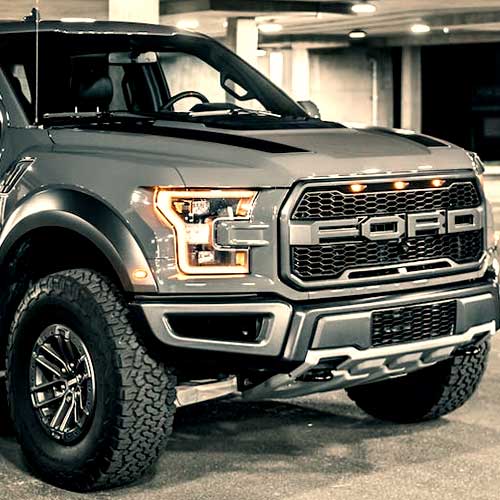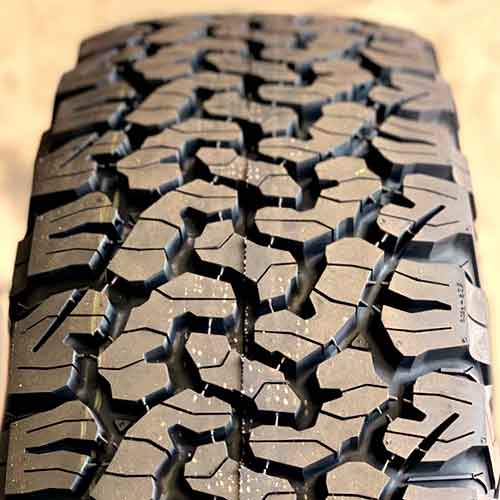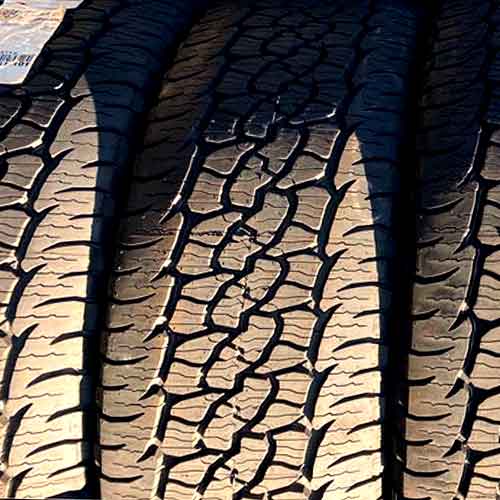Both these tires from BF Goodrich are although made all terrain, they provide very different performance efficacy, on and off road. The BF Goodrich Trail Terrain is the newest addition to the A/T line up, which focuses more on highway performance. Whereas, the BF Goodrich KO2 is known for it’s superb capabilities on rugged tracks, with it’s excellent durability.

Being a tire engineer, from my perspective, the BF Goodrich Trail Terrain T/A is definitely a better tire on pavements, as the tire offers better handling stability, and overall grip. On the other side, the BF Goodrich KO2 provides a significant performance off-road, and is also much more durable in comparison, with its 3 ply sides. Furthermore, both tires are really good in snow and are labeled with 3 peak mountain snowflake ratings. Though, they can really use some wet traction.
Let’s start things off, by checking out the important features of both tires.
Where BF Goodrich Trail Terrain is better?
- It offers better dry grip, handling and steering response.
- Less on road noise and better comfort is seen.
Review this tire in detail: https://tiredriver.com/bf-goodrich-trail-terrain-review/
Where BF Goodrich KO2 is better?
- Although not so great on wet roads, still on par with BFG Trail Terrain.
- Very durable with 3 ply sidewall construction.
- Impressive off road traction (except for the mud).
Review KO2 in detail: https://tiredriver.com/bf-goodrich-ko2-review/
Durability Differences
It’s no surprise to see BF Goodrich KO2 being a more durable tire out of the two. In fact, BFG claims, it’s their toughest tire ever built, they even dropped it from 10,000 feet and I know it’s true because it’s inner construction is very powerful.
The tire provides a 3 ply polyester casing. This polyester cover is then wrapped with 2 layers of steel belts.
And all of this is then spirally wound with nylon, so the sidewalls (which is considered the weakest part of the tire) get to have 3 ply polyester and 2 ply nylon reinforcements. That’s why in my list of top all terrain tires, this tire ranks best for durability.
The Trail Terrain, in comparison comes with typical 2 ply polyester, 2 steel belts and a single nylon ply construction.
For Your Info: The 3 ply polyester construction is very rare in all terrain tires, there’s one other (marketed A/T), the Mickey Thompson Baja Boss A/T (review), and even this tire is less durable overall compared to KO2.
Tread Appearance
Both tires although from the same company look very different.

Starting with BF Goodrich KO2, the tire offers a very uniform design of small blocks inter-linked with each other, making a web of grooves.
All of the central blocks have full depth siping, which split up the blocks further (this helps in off road traction).
On the outer extremity of these central blocks, triangular stone ejectors are embedded, which helps throw out dirt and stones, and provide better potency over traditional stone ejectors (which are also available on this tire, between shoulder blocks).
Speaking of shoulders, the tire is very aggressive here. It’s lugs are staggered and are equipped with prominent mud scoops, giving a very wild look.
The angled cuts on the blocks provide further biters, and the sidewall lugs help when the tire is ran with lowered pressure.

On the other hand, the BF Goodrich Trail Terrain presents staggered shoulder blocks and similar sidewall lugs (though not as aggressive).
The shoulder blocks don’t divide up (fittingly) as there is a continuous ribs with traction notches through out.
The ribs on each side of the tire, forms circumferential channels which divide the central blocks.
In the middle, the compactly packed blocks provide a lot of biting, as they have sharp off set edges and full depth siping.
This siping design splits open the blocks further just like seen on the BFG KO2’s tread.
Other than that, the tire although does not offer traditional stone ejectors, it still features triangular ones (like the KO2), hidden in it’s grooves.
Overall, with less open design, it can be seen that the center of attention with this tire is on-road traction. Let’s get to that but first, some info about their sizes.
Info about tire sizes
Starting with BF Goodrich Trail Terrain, the tire comes in 44 different sizes which go from 15 to 22 inches rim sizes. (FYI, only one size is available in 15, 235/75R15).
The tire is available in T and H speed ratings and if I talk about load range, it shows up in either XL or SL.
Tread depth is lower in comparison, and almost all sizes have 12.5/32″.
And lastly, weight of the tire ranges from 30 to 46 lbs.
On the other side, the BF Goodrich KO2 offers 90 sizes, more in comparison, but the tire is also available from 15 to 22″ rim sizes.
Speed ratings are available in either S or R (where 2 sizes also come with Q), while the load rating goes from C to E, with weight ranging form 35 lbs to 67 lbs.
And if I talk about tread depth, with the exception of 4 sizes, the rest get to have 15/32″.
The rest 4 are 215/65/R16, 225/65/R17, 245/65/R17, and 255/55/R18. These have 13/32″ of tread depth and come in LT sizes.
Winter Performance
When it comes to snowy terrains, there are a lot of subcategories, there’s on road snow, deep snow, ice, etc, all of them demand different features from tires.
Now the good things about both of these tires is that they are both 3 peak mountain snowflake rating, so at-least they are great in acceleration.
For Your Info: The 3PMSF rating is just an acceleration test, some folks confuse it with overall winter performance metric.
But of these two tires, the BF Goodrich KO2 lacks slightly due to it’s stiffer construction, so with freezing temperatures, it’s tread hardens up further (that’s why winter tires are so soft).
Nonetheless, the KO2’s interlocking ribs provide efficient snow trapping and this helps the friction and traction by making a better snow to snow contact. Moreover, it’s wider grooves also deals with deeper snow nicely.
On the flip side, the BF Goodrich Trail Terrain delivers very respectable braking distances, offering solid grip and predictable handling.
Its softer rubber compound gives the sipes more flexibility, which helps improve traction in various conditions.
I’ll admit, when I first saw the tire, I thought it might be too soft and wear out quickly. But surprisingly, that’s not the case.
I mean it strikes a nice balance between flexibility and durability, making it a reliable choice for everyday driving and light off-roading.
Comfort and Noise
With a high polymer composition of BF Goodrich Trail Terrain, the tire where it gives more flexibility to siping, also makes the tire spongy. So, with that, the tire diminishes the imprecations of the road in a better way.
Also with continuous shoulder ribs, the tire is one of the most silent all terrain tires you can get, as most of the noise enters trough the shoulders and there no way to get in.
On the other side, although the placement of blocks on BF Goodrich KO2 provide variable pitches through out which dampens on road noise, it’s still not enough to outperform its little brother.
The tire also provides a stiffer construction especially from the sides (as it has more number of inner layer), so the impacts don’t get dissipated as efficiently as the Trail Terrain.
For Your Info: The most silent tires out there is Continental TerrainContact AT, and the BFG Trail Terrain is only 2 decibels shorter.
Tread Wear
In terms of wear, the tire’s composition matters a lot, so with tough construction, the BF Goodrich KO2 provides a very slow wear rate. It’s stiff chip & cut resistant rubber included certain polymers which don’t let the rubber go off too easily. These mostly have Kevlar compounds which takes a while to wear off.
Furthermore, the BF Goodrich also has the advantage of more tread depth, 15/32″ compared to Trail Terrain’s 12.5/32″, and although it’s a smaller difference, it really affects tread wear in long term.
But on average both tires show similar tread life. As on BF Goodrich Trail Terrain, although it provides a softer rubber, it’s less aggressive design does not provide as high a rolling resistance as the KO2, so less rubber burns off.
That’s why being a more on road oriented tire, BF Goodrich Trail Terrain provides you with 60k miles warranty, while the BF Goodrich KO2 provides 50k.
On Road Performance
On road, there are some factors to consider, and out of them the 2 most crucial ones are grip and handling.
The grip is measured by calculating the braking distances, while the handling is linked with lateral traction (calculated with G forces).
Let’s check out both one by one.
Dry Traction
On dry roads, the BF Goodrich Trail Terrain continuous shoulder blocks provide a great contact with the road. As there are no grooves there, more rubber meets the surface, which results in more grip, naturally.
But with continuous ribs on sides, the tire lacks in the lateral traction component, which is highly needed during handling.
The KO2 on the flip side, although does not provide a good rubber to road contact, it’s consistent design and stiffer rubber still provides sufficient traction overall.
Steering Response
Both tires have their own unique dynamic responses, and there’s definitely a learning curve to each. So it might take some time to get used to how they handle and communicate with the driver.
Now out of the two, the BFGoodrich KO2 is a bit less expressive in terms of feedback. I mean it’s not as quick to communicate through the steering wheel, which can make it feel a little less responsive at times.
On the other hand, the Trail Terrain offers more stability, especially at higher speeds on paved roads. This comes down to its well-rounded design and better grip compared to the KO2.
So overall if you’re looking for a tire that feels more planted and predictable on the road, the Trail Terrain has the edge.
Handling Stability
Handling stability has to do with sides of the tire and overall weight. Now even with high ply construction, the BFG KO2 is not that heavier, but it’s stiffer sides compromises it’s stability.
The BF Goodrich Trail Terrain on the other side, shows a well balanced handling. It’s compact design keeps it’s softer rubber blocks steady even when turning sharply. But this goes for dry conditions, as on wet, things are not impressive.
Wet Performance
In wet conditions, the first thing to understand is that water is not compressible, so the best way to make grip on water is to remove it.
And it gets removed by sipes and grooves, which provide wet grip and hydroplaning resistance, let’s discuss them both one by one.
Wet Traction
In terms of wet traction, the sipes have to be flexible enough to squeeze and make vacuum to suck in the water particles coming underneath.
And that’s not an issue for BF Goodrich Trail Terrain, as the tire provides soft enough rubber compound which provide a good amount of flexibility to it’s sipes.
But this only provides this tire with wet grip, and in the handling department, it’s only as good as the BF Goodrich KO2, which is not impressive to begin with.
This is because the siping design of the tire is not that effective, they don’t form an interlocking pattern, so with this, on corners, the sipes make the blocks stiffer, and with continuous ribs on the shoulders, a lot of flexibility of these blocks is already compromised.
For Your Info: One of the best tires (in A/T category) for wet traction is Falken Wildpeak AT3w (review).
Hydroplaning
Hydroplaning resistance basically tells, how efficient a tire is in cleaning itself off from water.
It’s an important metric as the more efficient the grooves are (in evacuating water), the less water there is for sipes to deal with.
That’s why the BF Goodrich KO2, which is more resistant to hydroplaning, is able to provide almost a same level of wet traction despite it’s aggressive design.
Off Road Performance
Off road, there are a lot of terrains to consider, but some most significant ones are listed below.
Mud traction
Mud is the ultimate challenge for all-terrain tires, and both these tires here face a tough time there.
But yes of course, the KO2 is better, as it comes with wider gaps in the grooves which provides it with slightly greater capability to remove mud from it’s tread
And this goes mostly for the lateral tread voids on shoulders, which forces the mud out, sideways (unlike the Trail Terrain).
Furthermore, it’s aggressive staggered shoulder also provide bigger mud scoops in comparison, and these help the tire get out when aired down in mud.
Sand Traction
Sand requires a delicate balance of digging in and maintaining forward momentum.
And here the BF Goodrich KO2 leans more toward digging, and its harder rubber and stiffer construction make it harder to keep moving, especially on slopes.
On the other hand, the Trail Terrain performs better in sand. Its design offers more rubber contact with the ground, and the thicker sidewall lugs flex more when aired down, making it easier to maintain momentum.
Recommended Read: Are A/T tires good on sand?
Traction on Rocks:
When it comes to rocks, the BF Goodrich KO2 is a champ. With 3 ply polyester construction, it give you the confidence you need to take them anywhere, may it be sharp rocks, thorns, logs… you name it.
It’s small central ribs with traction notches everywhere and full depth siping which allows the blocks to split open and close, create a very decent biting power.
When you lower the pressure on this tire, it’s serrated shoulders and slanted sidewall lugs provide an additional footprint, which with deep notches, grab and pull efficiently.
The BF Goodrich Trail Terrain although has similar-looking sidewall lugs that offer decent flexing, but its less aggressive shoulders limit lateral traction on rocks.
That said, both tires perform well on gravel, thanks to their cut- and chip-resistant rubber. And yes, they also feature triangular stone ejectors that efficiently clear stones from the grooves.
Fuel Efficiency
BF Goodrich Trail Terrain comes in the list of best all terrain tires for fuel, it’s the second most fuel efficient tire, that I’ve reviewed, (the first being Firestone Destination AT2).
The tire offers very good grip on roads and at the same time does not produce a lot of rolling resistance, it’s very light in weight and with it’s optimized footprint, it does not push on pavements with a lot of pressure.
But keep in mind, it’s fuel efficiency is dependent on the environment, as with higher temperature, it’s fuel economy goes down.
On the other side, the BF Goodrich KO2 is also not too far off either, the tire’s stiffer rubber compound and consistent pattern provides decent fuel efficiency. The stiffer compound is better as less compression occurs with the ground but with more weight, it offers more rolling resistance in comparison.
So switching between these tires, you are going to see a difference of almost 1 mpg (going from E rated BFG KO2).
What’s the verdict?
So overall BFG Trail Terrain is a nice on road oriented all terrain option.
On roads and pavements, the tire gives you decent ride quality with its smoother and quieter ride.
And traction wise, things are also okay on dry, but still can be improved on wet, as there isn’t much difference when compared to traction on BFG KO2 (which is not good on wet to begin with).
On snow both tires are great and their 3 peak mountain snowflake rating is justified as they offer enough traction there.
But on rugged terrains, the BF Goodrich Trail Terrain does not hold up as much as the KO2, and that makes sense, as it’s less aggressive and not as durable with 2 ply sidewalls compared to KO2’s 3 ply.
Side Note: If you’ve used these tires, how was your experience? Any pros or cons you’d like to add? Comment below!
Had KO2’s on a 4Runner and put over 100K on them and probably could have made it another winter with plenty of tread – replaced with TT’s and have been impressed right away on how much quieter they are!
Great review on both!
Yes, they are very quiet indeed. Though if you’re looking for quietest A/T tire out there, I have to say its Continental TerrainContact A/T, just putting it out there. Review this tire here.